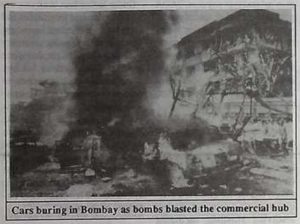
BOMBAY: Indian authorities may or may not lay their hands on those who planted bombs at more than 14 places. But the design behind the action is by now quite clear: it ‘Was intended to hit India’s Hindu economy. The selection of the Bombay stock exchange as a special target was evidently aimed at throwing the entire economic fabric in chaos. The message has been clearly understood by the Indian prime minister and other top authorities who stated so in their statements immediately after the incidents although the blame was put on the external forces: More than 325 people were killed and over a thousand were wounded as a series of powerful explosions thundered across the financial capital of India, spreading terror and panic in a city still shaken from riots between Hindus and Muslims in December and January.
The first of 14 blasts went off at 1:25 p.m. at the 29 story Bombay Stock Exchange, where the lower floors were destroyed and an estimated 50 people were killed, many of them traders, stock brokers and people crowded around food stands and tea stalls.
Within an hour, the city was further rocked by explosions at the skyscraper that houses the headquarters of Air India, as well as Government offices, a passport office, an airline office, banks, movie theaters, cars and two hotels,
The police said the blasts appeared timed to paralyze business and trading and create fear among the people of Bombay, No group stepped forward to take responsibility, and the authorities gave no indication that they knew who might have carried them out.
But the explosions were certain to deepen suspicions between the city’s Hindu and Muslim communities, already living in fear because of the recent sectarian riots. Most observers in India knew that Muslim youths were in an angry mood after the Ayodhya incidents of December 5. Many columnists wrote that the Muslim youths had rejected the traditional Muslim leadership, Not only the entire community felt collectively humiliated as the 467 year old shrine at Ayodhya became rubble at the hands of Hindu fundamentalists but it suffered extensive loss in terms of men and material as well. More than 2000 Muslims, mostly protesting youths, were shot down by the Indian police. What is particularly notable is the fact that Volunteers of Hindu Shiv Sena at Bombay tad made Muslim business establishments their prime target in January and had destroyed numerous shops and factories.
It is against this background that one has to assess the motives behind the Bombay blasts, The aim evidently was to hit back at the Hindu business, It was most Probably Muslim tat for Hindu tit. ‘The Indian authorities evidently know the truth, But it is not being Projected in so many words for Obvious reasons. The entire blame is being laid on the external forces or more specifically “the neighbor” (Pakistan), Also, already the Indian authorities have picked up two Muslim youths, Asghar Ali Tahar Ali and Fandbhai, in connection with the blasts. But by and by the Indian authorities are likely to turn to the local factor as is evident from a statement by Indian home Minister S,B .Chavan that it is too early to hold the Pakistan intelligence for the incidents.
As soon as the local factor surfaces more specifically, the danger is that Hindu fundamentalists will plan an elaborate attack on Muslim economic interests. It is already in the air that the R.S.S. has marked the Muslim houses in major towns in north India for a possible future attack. Also in the air is the possibility of large scale aggression on Muslim industrialists at Kanpore and other major U.P. towns. At Kanpore, Muslims have predominance in skin, hides and leather business while at Moradabad they have significant Presence in utensils. At Aligarh they have vital interests in locks manufacture business.
Already thousands of Muslim workers engaged in Hindu owned industries at Bombay fled from here last month. Leading industrialists tried to persuade the Muslim workers not to leave but they were reluctant to stay on as the authorities would not ensure their safety against Shiv Sena at tacks,
It is quite likely that the business establishments of foreign powers will come in the Hindu-Muslim ¢crossfire in the event of any such power throwing its weight behind one or the other side, Thus, according to political observers here, the U.S. administration is courting the danger by giving an impression of its agreement with the Indian view of the Bombay blasts being an act of “Muslim terror ism.” That is precisely what comes out of a meeting the Indian ambassador to the U.S. S.S.Ray had with unidentified U.S. officials early this week.
Meanwhile, Indian authorities succeeded in restoring a modicum of normality at the Bombay stock exchange on Monday, within two days of the car bomb blasts that damaged the basement and three stones of the 29storey exchange, Very few scrip were traded and as a result of intervention by the Indian government controlled financial institutions the exchange index went up by 2.55% over its pre bombing level. This was evidently aimed at sending a message internationally that India’s economic fabric is unharmed.
The death toll went up to 325 while about a 1000 persons were Struggling for life in the various hospitals of Bombay as the last reports came in from there, Several buildings were damaged. The Bombay stock exchange building suffered a loss of about Rs 10 crore, according to its executive director.
Article extracted from this publication >> March 19, 1993